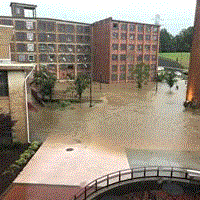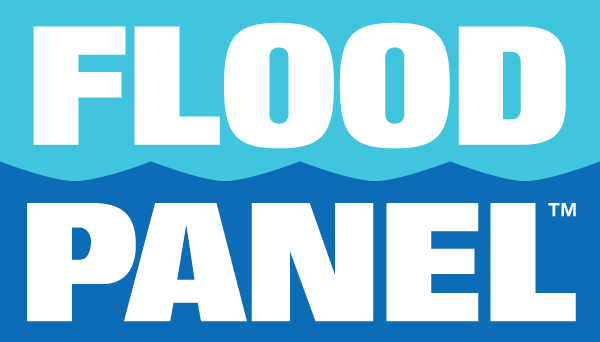Media Contact
Email: [email protected]

U.S. military bases on the nation’s coastline are at increased risk to “catastrophic damage” from flooding due to rising sea levels, according to a recent article by NBCNews and InsideClimate News.
The National Oceanic and Atmospheric Association reports that global sea level is rising, and at an increasing rate. “In 2014, global sea level was 2.6 inches above the 1993 average—the highest annual average in the satellite record (1993-present).”
Rising sea levels expose many coastal communities to increased flooding caused by high tides and storms. According to NOAA, nuisance flooding from high tides and rain events is as much as “900 percent more frequent within U.S. coastal communities than it was just 50 years ago.”
Many of America’s strategic military bases are vulnerable to flooding, according to another report by the Union of Concerned Scientists. The Kennedy Space Center (Florida), US Naval Academy (Maryland), Washington Navy Yard (DC), and the Naval Air Station Key West (Florida) are among those at greatest risk.
The Norfolk Naval Shipyard in Virginia is in particular peril. The site is one of only four shipyards designed to maintain the U.S. arsenal of nuclear submarines and aircraft carriers, critical to U.S. defense and humanitarian missions. In the last ten years, the shipyard was impacted by nine major floods. Each event caused equipment damage and maintenance delays that affected the entire U.S. naval fleet.
Sea level at Norfolk has risen 1.5 feet in the last 30 years causing an increase in nuisance flooding. After Hurricane Matthew dumped historic rain on the area, the Navy spent $1.2 million to repair one building badly damaged by flooding.
Most experts agree that a looming disaster for the shipyard is not a question of if, but when. Hurricane Florence came close to Norfolk in September 2018, veering south to bring a flooding crisis in Wilmington, N.C.
A recent computer simulation of a Category 4 Hurricane on Norfolk by the Federal Emergency Management Agency predicts a 12-15 foot storm surge that would submerge the entire area. A news release described the potential disaster as “New Orleans without the levee system.”
The military has been sitting on this issue for years. In 2010, the Quadrennial Defense Review made it clear that climate change should be a Department of Defense priority. In 2011, a Navy-commissioned National Research Council report warned that 56 Naval facilities worth $100 billion would be threatened if sea level rose three feet.
Since that report was published, little has been done to protect these assets from the threat of rising sea levels. Political resistance to climate change issues has blocked or slowed efforts to fund resiliency projects that would shore up America’s defenses before it is too late.
In Norfolk, the Navy dodged disaster in 2018, but climate change and rising sea levels remain a clear and present danger to U.S. military might.
Photo by Eli Christman, Creative Commons License

When one hears the name, “Tangier Island”, pleasant thoughts of tropical vistas with swaying palm trees might come to mind. But in reality, Tangier Island is located off the coast of Virginia, and its primary claim to fame is not balmy beauty but the fact that the island has lost almost 70% of its land mass since the year 1850. Today, Tangier Island is a fast-disappearing symbol of climate change and sea level rise.
According to the most recent census, 727 people make their homes on Tangier Island, which has an area of about one square mile. The island is sandy and sits at a very low-elevation; most of the land is just 3-4′ above sea level. The problem for the inhabitants of this island is that sea level is increasing every year, and at the same time, the land itself is sinking due to the residual effects of an ancient glacier. According to most estimates made by environmental scientists, the entire island will be swallowed by the sea over the next 50 years… if the island keeps losing land at the current rate.
Tangier Island is part of a vulnerable group of islands scattered across the Chesapeake Bay. In the past, these islands numbered well over 500, and were important summer residences for Native American people. The islands even today are rich with oyster beds and crab fisheries, and these resources sustained Native American populations for hundreds of years before the Europeans arrived. Huge piles of ancient oyster shells have been found on the islands, including Tangier, as well as thousands of arrow and spear heads. The weapons are evidence that the islands were once much larger than they are today, and that they supported healthy populations of larger game animals.
Once the Europeans arrived at the Chesapeake Bay, things changed quickly. Native American populations were decimated by disease, encroachment, and the technological advantages of the invaders. A population of British seafarers and fishermen drove off the Native Americans, and settled on Tangier Island. Many habitants living there today are descendants of these hardy seamen, and still bear the old surnames and- because of the extreme isolation of the island- even now present the accented English of their forebears.
However, no amount of pluck and perseverance will be able to save the current residents of Tangier Island. Already today, the island is being swallowed by the sea, and the future looks grim even by the most optimistic of estimates. The land that is still above water is becoming marshy and squishy underfoot, and the sea swallows many meters of coastline every year. People who own homes and businesses on Tangier find themselves looking at a future of homelessness and displacement, with no hope of being able to sell off their assets.
While there is is currently a prospective rescue plan for the island, the plan is projected to cost in the range of $30m- a figure that is completely untenable to save an island important only to the 700 people who live there. And Tangier Island is only one of many endangered inhabited islands on the Chesapeake Bay- why save this particular island and not the others? At the same time, the coastal cities that line the Eastern Seaboard are competing for limited funds to install flood barriers, berms, and other flood control devices in order to stave off inundation. Flooding will be an ever-increasing part of life for all who live near the sea. For those who live surrounded by the sea, flooding will soon claim their entire world.
Source: FloodBarrierUSA
In September 2018 at historic Revolution Mill in Greensboro, North Carolina, Hurricane Florence threatened with high wind, rain and storm flooding. The structure weathered the worst of the storm thanks to Flood Log™ flood barriers from Flood Panel LLC.
Revolution Mill is a unique building complex that houses more than 100 businesses, meeting and conference facilities, 150 loft apartments, outdoor performance spaces, public art galleries, restaurants, coffee shops, greenway trails and more.
On the National Registry of Historic Places, the building was the first flannel mill in the South and by 1930 was the largest exclusive flannel producer in the world. Manufacturing in North Carolina declined in the mid-1900s and the Mill eventually closed. In 2012, a $100 million redevelopment project transformed the site into its current state.
Revolution Mill sits along North Buffalo Creek, a stream prone to flooding from seasonal rainstorms and hurricanes. Recognizing the vulnerability of this historic space, management purchased Flood Logs from Flood Panel LLC to protect the site from water damage during a flood event.
Hurricane Florence began like many hurricanes in the Atlantic, as a tropical wave off the coast of Africa first identified by meteorologists on August 30, 2018.
By September 7, Florence had strengthened to a Category 4 hurricane with a bullseye on the North Carolina coast. Two weeks after it was first identified, Hurricane Florence made landfall in Wilmington, N.C. on September 14 as a Category 1 hurricane.
Gradually the storm weakened, but began to slow down moving only 2-3 miles per hour. Storm surge plus historic rainfall caused catastrophic flooding along the North Carolina coast. At one point, the entire city of Wilmington was completely cut off by flooded roadways. Some places recorded over 30 inches of rainfall and many rivers overflowed their banks.


Management at Revolution Mill was ready for major flooding due to sudden storms, flash floods and hurricanes. They had 27 sets of Flood Logs to safeguard the structure.
Fortunately, Hurricane Florence gave the building maintenance crew a lot of time to prepare. “We saw it coming and we were watching developments,” said Don Elliott, Maintenance Supervisor, Revolution Mill. “We had a crew on site to put the Flood Logs up as soon as we knew we needed them.”
According to Elliott, they deployed 22 of the 27 sets of Flood Logs to secure the most vulnerable openings. Installation was fast and easy.
Although many businesses in North Carolina sustained major damage from the storm, Revolution Mill was spared. Flood water was an issue at only one of the protected entryways.
The Flood Logs held up to the rising water, which rose to three feet on one side of the building. According to Elliott, “Water rose outside an area of the building under renovation to become retail space. The water would have caused a lot of damage.”
Once the danger had passed, Revolution Mill stored the Flood Logs on custom racks. For now, they sit idle in storage, but ready for the next storm.
One of the most destructive aspects of storms like Hurricane Florence is the catastrophic flooding caused by storm surge and prolonged heavy rainfall. Water damages or destroys many homes and businesses thought to be out of harm’s way.
When flooding strikes, building owners need to know that their property and assets will be protected. Flood doors, flood panels and other flood barrier solutions can provide some peace of mind in a flood event. But how can one know with any degree of certainty that those measures will work?
Several years ago, at a conference sponsored by the Association of State Flood Plain Managers and the U.S. Army Corps of Engineers, attendees called for a national program to test flood barriers that would standardize quality and differentiate products that worked from those that did not.
Meanwhile, FM Global, one of the world’s largest business and property insurers, was also taking steps to address the problem at its insured facilities worldwide. In 2006, its subsidiary FM Approvals created a standard for testing and certifying flood loss prevention products. FM Approvals Standard 2510 was adopted by the American National Standards Institute. It is the only U.S. national standard for flood barrier products.
In 2012, ASFPM partnered with USACE and FM Approvals to develop the National Flood Barrier Testing & Certification Program based on the ANSI/FM Approvals Standard 2510. It “assures manufacturers and consumers that a product, which has been objectively tested, conforms to national standards.” The program awards national recognition and FM Approval certification for products that meet requirements.
Flood barrier certification requires a battery of tests, audits of the manufacturing facility and supporting operational guidelines. This process ensures certified flood solutions will stand up to waves, hydrostatic forces and impact from floating debris. FEMA and the National Flood Insurance Program have adopted the requirements for floodproofing nonresidential structures.
The testing and certification program is a five-step process that includes 1) Application, 2) Proposal Issue and Manufacturer Authorization, 3) Testing and First Audit, 4) Report and Certification, and 5) Follow-up Audits.
The program evaluates temporary perimeter barriers, set just before a flood event, and opening barriers including doors, windows and vents. It includes component testing, performance (water) testing and manufacturing facility auditing. According to an FM Approvals representative, each step is important because “a product is only as good as its weakest link.”
The USACE conducts water testing to “examine the ability of a product to withstand flood related exposure, such as hydrodynamic, overtopping, velocity and debris.” FM Approvals manages materials testing to “examine the ability of a product to withstand the forces of nature that impinge upon the product when deployed.”
The USACE evaluates temporary perimeter barriers at its facility in Vicksburg, Mississippi. Tests on closure barriers can be conducted in Vicksburg, at a manufacturing facility or at an independent laboratory approved by FM Approvals. The Flood Lab at Flood Panel LLC headquarters in Jupiter, Florida is an example of an approved manufacturer facility.
Manufacturers are also required to develop a “Design, Installation, Operation and Maintenance Manual” that outlines repair and replace instructions for the product. Additionally, the manufacturer must create a post installation checklist to be completed by the installer and kept on file at the manufacturer facility.
FM Approvals visits the manufacturing facility to confirm that quality guidelines are set to ensure consistent production of the product. During these audits, FM Approvals also verifies that completed installation checklists are on file.
Finally, FM Approvals conducts periodic follow-up audits at the manufacturing facility to ensure that nothing has changed with the certified product.
The flood barrier certification and testing program outlines three levels:
Tom Osborne, president of Flood Panel LLC, compares the certification program to other standards, such as UL Listings or Fire-Safety Ratings, which assure consumers that building products meet standards set by the industry.
Building owners want assurance that their flood prevention safeguards will keep water out when flooding occurs. The National Flood Barrier Certification & Testing Program delivers third-party, objective testing of important flood protection solutions to answer the most important question, “Will it work?”
Visit nationalfloodbarrier.org for more information and a webinar about the National Flood Barrier Testing & Certification Program.
